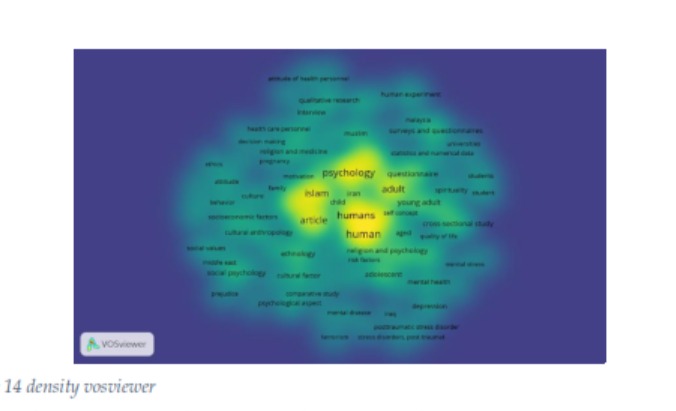Analysis of Self-Harm Behavior in Islamic Psychology: Trends, Impact, and Future Research Directions through Bibliometric Study
DOI:
https://doi.org/10.69526/bir.v1i2.344Keywords:
Self-Harm, Mental Health, Psychology, Islam, BibliometricAbstract
This study aims to conduct a bibliometric analysis related to self-harm behavior in Islamic psychology. The bibliometric analysis technique is used to browse all publications indexed in the Scopus database and the data obtained is analyzed using Excel, R-studio, and VOSviewer. This research method involves searching and analyzing scientific articles related to Islamic psychology such as keywords, number of publications per year, key data information, number of citations, prolific researchers, and place of publication related to this study, to provide an understanding of the development and impact of research in this field. The results of the bibiometric analysis show that self-harm behavior in Islamic psychology has become an increasing subject of research in recent years as well as a significant increase in the number of publications in this field. The limitation of this study is that it only takes datasets or metadata of publications indexed in Scopus. Other national and international databases were not considered in this study. This study presents a brief overview of the literature that researchers can access and provides recommendations for future research.
References
Céline, B, B François, and S Stanislas. “Physical and Psychosocial Factors Associated with Psychostimulant Use in a Nationally Representative Sample of French Adolescents: Specificities of Cocaine, Amphetamine, and Ecstasy Use.” Addictive Behaviors 92 (2019): 208–24. https://doi.org/10.1016/j.addbeh.2018.11.046.
Chiesa, M, and P Fonagy. “From the Therapeutic Community to the Community: A Preliminary Evaluation of a Psychosocial Outpatient Service for Severe Personality Disorders.” Therapeutic Communities 23, no. 4 (2002): 247–59. https://www.scopus.com/inward/record.uri?eid=2-s2.0-0036949498&partnerID=40&md5=8ee9edcf14e75774c9c1398620a7fa02.
Cully, G, P Corcoran, D Leahy, E Griffin, C Dillon, E Cassidy, F Shiely, and E Arensman. “Method of Self-Harm and Risk of Self-Harm Repetition: Findings from a National Self-Harm Registry.” Journal of Affective Disorders 246 (2019): 843–50. https://doi.org/10.1016/j.jad.2018.10.372.
Edel, M.-A., V Raaff, G Dimaggio, A Buchheim, and M Brüne. “Exploring the Effectiveness of Combined Mentalization-Based Group Therapy and Dialectical Behaviour Therapy for Inpatients with Borderline Personality Disorder – A Pilot Study.” British Journal of Clinical Psychology 56, no. 1 (2017): 1–15. https://doi.org/10.1111/bjc.12123.
Forkus, S R, J G Breines, and N H Weiss. “Morally Injurious Experiences and Mental Health: The Moderating Role of Self-Compassion.” Psychological Trauma: Theory, Research, Practice, and Policy 11, no. 6 (2019): 630–38. https://doi.org/10.1037/tra0000446.
Ghaderi, M, Q Ahi, S Vaziri, A Mansoori, and ... “The Mediating Role of Self–Criticism and Distress Tolerance in Relationship between Attachment Styles and Non-Suicidal Self-Injury Behaviors in Adolescents.” Journal of Research in …, 2020. http://rbs.mui.ac.ir/article-1-703-en.html
Glazebrook, K, E Townsend, and K Sayal. “The Role of Attachment Style in Predicting Repetition of Adolescent Self-Harm: A Longitudinal Study.” Suicide and Life-Threatening Behavior 45, no. 6 (2015): 664–78. https://doi.org/10.1111/sltb.12159.
Hartig, A, C Voss, L Herrmann, S Fahrenkrug, C Bindt, and I Becker-Hebly. “Suicidal and Nonsuicidal Self-Harming Thoughts and Behaviors in Clinically Referred Children and Adolescents with Gender Dysphoria.” Clinical Child Psychology and Psychiatry 27, no. 3 (2022): 716–29. https://doi.org/10.1177/13591045211073941.
Hurlock, Elizabeth B. “Psikologi-Perkembangan-Elizabeth-B-Hurlockpdf_Compress.Pdf.” INews.Id, 2021.
Jacups, S, and B Rogerson. “Lifetime Influences for Cannabis Cessation in Male Incarcerated Indigenous Australians.” Journal of Psychoactive Drugs 47, no. 2 (2015): 117–24. https://doi.org/10.1080/02791072.2015.1014949.
Koly, K N, A Anjum, R Muzaffar, T Pollard, T Akter, Z Rahman, H U Ahmed, and J Eaton. “Self-Reported Suicidal Behaviour among People Living with Disabilities: Prevalence and Associated Factors from a Cross-Sectional Nation-Wide Survey in Bangladesh.” BMC Psychology 12, no. 1 (2024). https://doi.org/10.1186/s40359-024-01699-5.
Leicester (UK): British Psychological Society (UK);, and National Institute for Health and Care Excellence: Guidelines. Self-Harm: The Short-Term Physical and Psychological Management and Secondary Prevention of Self-Harm in Primary and Secondary Care. Leicester (UK), 2004.
Lewis, G F, L Hourani, S Tueller, P Kizakevich, S Bryant, B Weimer, and L Strange. “Relaxation Training Assisted by Heart Rate Variability Biofeedback: Implication for a Military Predeployment Stress Inoculation Protocol.” Psychophysiology 52, no. 9 (2015): 1167–74. https://doi.org/10.1111/psyp.12455.
Lewis, S P, T E Kenny, K Whitfield, and J Gomez. “Understanding Self-Injury Recovery: Views from Individuals with Lived Experience.” Journal of Clinical Psychology 75, no. 12 (2019): 2119–39. https://doi.org/10.1002/jclp.22834.
Lidón-Moyano, C, D Wiebe, P Gruenewald, M Cerdá, P Brown, and S Goldman-Mellor. “Associations between Self-Harm and Chronic Disease among Adolescents: Cohort Study Using Statewide Emergency Department Data.” Journal of Adolescence 72 (2019): 132–40. https://doi.org/10.1016/j.adolescence.2019.03.005.
Liebman, R E, and M Burnette. “It’s Not You, It’s Me: An Examination of Clinician- and Client-Level Influences on Countertransference Toward Borderline Personality Disorder.” American Journal of Orthopsychiatry 83, no. 1 (2013): 115–25. https://doi.org/10.1111/ajop.12002.
Muehlenkamp, J J, T W Ertelt, A L Miller, and L Claes. “Borderline Personality Symptoms Differentiate Non-Suicidal and Suicidal Self-Injury in Ethnically Diverse Adolescent Outpatients.” Journal of Child Psychology and Psychiatry and Allied Disciplines 52, no. 2 (2011): 148–55. https://doi.org/10.1111/j.1469-7610.2010.02305.x.
Naylor, A, D Buckmaster, C Watsford, E McIntyre, and D Rickwood. “Preparing Master of Clinical Psychology Students for the Workforce: A Qualitative Investigation of the Benefits of a Youth Dialectic Behavioural Therapy Placement.” Clinical Psychologist 27, no. 3 (2023): 352–62. https://doi.org/10.1080/13284207.2023.2227768.
O’Hare, K, A Hussain, K R Laurens, G Hindmarsh, V J Carr, S Tzoumakis, F Harris, and M J Green. “Self-Reported Mental Health of Children Known to Child Protection Services: An Australian Population-Based Record Linkage Study.” European Child and Adolescent Psychiatry 32, no. 1 (2023): 101–12. https://doi.org/10.1007/s00787-021-01841-3.
Ohlis, A, J Bjureberg, P Lichtenstein, B M D’Onofrio, A E Fruzzetti, M Cederlöf, and C Hellner. “Comparison of Suicide Risk and Other Outcomes among Boys and Girls Who Self-Harm.” European Child and Adolescent Psychiatry 29, no. 12 (2020): 1741–46. https://doi.org/10.1007/s00787-020-01490-y.
Rini, Rini. “Perilaku Menyakiti Diri Sendiri Bentuk, Faktor Dan Keterbukaan Dalam Perspektif Perbedaan Jenis Kelamin.” IKRA-ITH HUMANIORA: Jurnal Sosial Dan Humaniora 6, no. 3 (2022): 115–23. https://doi.org/10.37817/ikraith-humaniora.v6i3.2213.
Shoib, S, A Y Armiya’u, M Nahidi, N Arif, and ... “Suicide in Muslim World and Way Forward.” Health Science …, 2022. https://www.ncbi.nlm.nih.gov/pmc/articles/PMC9178353/.
Sinclair, E.S.-L.L., L Clark, M J A Wohl, M T Keough, and H S Kim. “Cash Outs during In-Play Sports Betting: Who, Why, and What It Reveals.” Addictive Behaviors 154 (2024). https://doi.org/10.1016/j.addbeh.2024.108008.
Xie, J, Y Yan, Y Hong, J Yang, M Bai, W Xia, and X Zhang. “Descriptive and Associated Risk Factors Analysis of Mental Disorders among Adolescents in Huangshi, China.” Asian Journal of Psychiatry 79 (2023). https://doi.org/10.1016/j.ajp.2022.103405.
Zhang, R, F Hou, Y Lin, Y Geng, and F Kong. “Associations between Emotional Maltreatment, Depression and Self-Harm among Chinese Adolescents: A Three-Wave Longitudinal Mediation Model.” Child Abuse and Neglect 152 (2024). https://doi.org/10.1016/j.chiabu.2024.106761.
Elizabeth B Hurlock, “Psikologi-Perkembangan-Elizabeth-B-Hurlockpdf_Compress.Pdf,” INews.Id, 2021.
Leicester (UK): British Psychological Society (UK); and National Institute for Health and Care Excellence: Guidelines., Self-Harm: The Short-Term Physical and Psychological Management and Secondary Prevention of Self-Harm in Primary and Secondary Care (Leicester (UK), 2004).
Rini Rini, "Self-Harm Behaviors Forms, Factors and Openness in the Perspective of Gender Differences," IKRA-ITH HUMANITIES: Journal of Social and Humanities 6, no. 3 (2022): 115–23, https://doi.org/10.37817/ikraith-humaniora.v6i3.2213.
S Shoib et al., “Suicide in Muslim World and Way Forward,” Health Science …, 2022, https://www.ncbi.nlm.nih.gov/pmc/articles/PMC9178353/.
M Ghaderi et al., “The Mediating Role of Self–Criticism and Distress Tolerance in Relationship between Attachment Styles and Non-Suicidal Self-Injury Behaviors in Adolescents,” Journal of Research in …, 2020, http://rbs.mui.ac.ir/article-1-703-en.html
C Lidón-Moyano et al., “Associations between Self-Harm and Chronic Disease among Adolescents: Cohort Study Using Statewide Emergency Department Data,” Journal of Adolescence 72 (2019): 132–40, https://doi.org/10.1016/j.adolescence.2019.03.005
K O’Hare et al., “Self-Reported Mental Health of Children Known to Child Protection Services: An Australian Population-Based Record Linkage Study,” European Child and Adolescent Psychiatry 32, no. 1 (2023): 101–12, https://doi.org/10.1007/s00787-021-01841-3
B Céline, B François, and S Stanislas, “Physical and Psychosocial Factors Associated with Psychostimulant Use in a Nationally Representative Sample of French Adolescents: Specificities of Cocaine, Amphetamine, and Ecstasy Use,” Addictive Behaviors 92 (2019): 208–24, https://doi.org/10.1016/j.addbeh.2018.11.046
G F Lewis et al., “Relaxation Training Assisted by Heart Rate Variability Biofeedback: Implication for a Military Predeployment Stress Inoculation Protocol,” Psychophysiology 52, no. 9 (2015): 1167–74, https://doi.org/10.1111/psyp.12455
A Ohlis et al., “Comparison of Suicide Risk and Other Outcomes among Boys and Girls Who Self-Harm,” European Child and Adolescent Psychiatry 29, no. 12 (2020): 1741–46, https://doi.org/10.1007/s00787-020-01490-y
K Glazebrook, E Townsend, and K Sayal, “The Role of Attachment Style in Predicting Repetition of Adolescent Self-Harm: A Longitudinal Study,” Suicide and Life-Threatening Behavior 45, no. 6 (2015): 664–78, https://doi.org/10.1111/sltb.12159
S R Forkus, J G Breines, and N H Weiss, “Morally Injurious Experiences and Mental Health: The Moderating Role of Self-Compassion,” Psychological Trauma: Theory, Research, Practice, and Policy 11, no. 6 (2019): 630–38, https://doi.org/10.1037/tra0000446
S Jacups and B Rogerson, “Lifetime Influences for Cannabis Cessation in Male Incarcerated Indigenous Australians,” Journal of Psychoactive Drugs 47, no. 2 (2015): 117–24, https://doi.org/10.1080/02791072.2015.1014949
J Xie et al., “Descriptive and Associated Risk Factors Analysis of Mental Disorders among Adolescents in Huangshi, China,” Asian Journal of Psychiatry 79 (2023), https://doi.org/10.1016/j.ajp.2022.103405
S P Lewis et al., “Understanding Self-Injury Recovery: Views from Individuals with Lived Experience,” Journal of Clinical Psychology 75, no. 12 (2019): 2119–39, https://doi.org/10.1002/jclp.22834
R E Liebman and M Burnette, “It’s Not You, It’s Me: An Examination of Clinician- and Client-Level Influences on Countertransference Toward Borderline Personality Disorder,” American Journal of Orthopsychiatry 83, no. 1 (2013): 115–25, https://doi.org/10.1111/ajop.12002
M.-A. Edel et al., “Exploring the Effectiveness of Combined Mentalization-Based Group Therapy and Dialectical Behaviour Therapy for Inpatients with Borderline Personality Disorder – A Pilot Study,” British Journal of Clinical Psychology 56, no. 1 (2017): 1–15, https://doi.org/10.1111/bjc.12123
M Chiesa and P Fonagy, “From the Therapeutic Community to the Community: A Preliminary Evaluation of a Psychosocial Outpatient Service for Severe Personality Disorders,” Therapeutic Communities 23, no. 4 (2002): 247–59, https://www.scopus.com/inward/record.uri?eid=2-s2.0-0036949498&partnerID=40&md5=8ee9edcf14e75774c9c1398620a7fa02
A Hartig et al., “Suicidal and Nonsuicidal Self-Harming Thoughts and Behaviors in Clinically Referred Children and Adolescents with Gender Dysphoria,” Clinical Child Psychology and Psychiatry 27, no. 3 (2022): 716–29, https://doi.org/10.1177/13591045211073941
A Naylor et al., “Preparing Master of Clinical Psychology Students for the Workforce: A Qualitative Investigation of the Benefits of a Youth Dialectic Behavioural Therapy Placement,” Clinical Psychologist 27, no. 3 (2023): 352–62, https://doi.org/10.1080/13284207.2023.2227768
E.S.-L.L. Sinclair et al., “Cash Outs during In-Play Sports Betting: Who, Why, and What It Reveals,” Addictive Behaviors 154 (2024), https://doi.org/10.1016/j.addbeh.2024.108008
R Zhang et al., “Associations between Emotional Maltreatment, Depression and Self-Harm among Chinese Adolescents: A Three-Wave Longitudinal Mediation Model,” Child Abuse and Neglect 152 (2024), https://doi.org/10.1016/j.chiabu.2024.106761
G Cully et al., “Method of Self-Harm and Risk of Self-Harm Repetition: Findings from a National Self-Harm Registry,” Journal of Affective Disorders 246 (2019): 843–50, https://doi.org/10.1016/j.jad.2018.10.372
J J Muehlenkamp et al., “Borderline Personality Symptoms Differentiate Non-Suicidal and Suicidal Self-Injury in Ethnically Diverse Adolescent Outpatients,” Journal of Child Psychology and Psychiatry and Allied Disciplines 52, no. 2 (2011): 148–55, https://doi.org/10.1111/j.1469-7610.2010.02305.x
K N Koly et al., “Self-Reported Suicidal Behaviour among People Living with Disabilities: Prevalence and Associated Factors from a Cross-Sectional Nation-Wide Survey in Bangladesh,” BMC Psychology 12, no. 1 (2024), https://doi.org/10.1186/s40359-024-01699-5.

Downloads
Published
Issue
Section
License
Copyright (c) 2023 Azmil Iman hartafan (Author)

This work is licensed under a Creative Commons Attribution 4.0 International License.



















